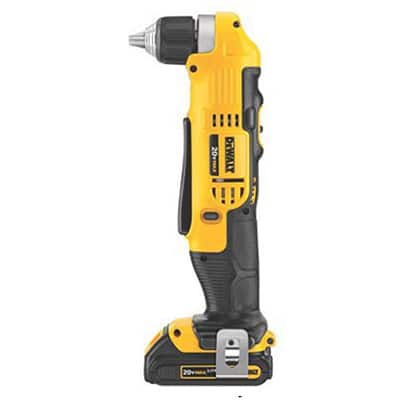Best Cordless Right Angle Drill — Buyers Guide, Top Pick, and Comparison
While releasing you from the handcuffs of mains power — the best cordless right angle drill units enable you to bore and drive in areas inaccessible by standard drills. Their slimline construction, 90-degree snub head, and lithium-ion cells mean you can effortlessly work beneath decking, inside cabinets, and between rafters — without the hassle of lengthy cables and extension cords. Furthermore, the small 90 degree drill models can function as secondary portable machines — for projects that don’t demand an industrial scale unit.
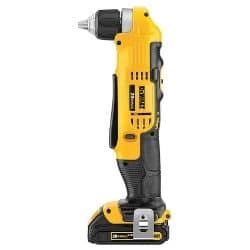
- 0.375-inch chuck.
- Complete kit — ideal for 90-degree novices.
- Keyless chuck.
- Twin speed.
- Maximum 2000 rpm.
Cordless Right Angle Drill Comparison Table
| IMAGE | PRODUCT | DETAILS | ||
|---|---|---|---|---|
|
Best Dual Speed

|
Best Dual Speed
|
DeWalt DCD740C1
|
Features
|
Check Price at Amazon DeWalt DCD740C1 Review DeWalt DCD740C1 Review |
|
Best Complete Kit
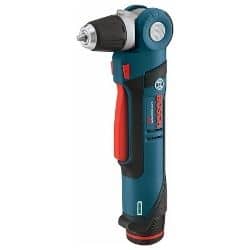
|
Best Complete Kit
|
Bosch PS11-102
|
Features
|
Check Price at Amazon Bosch PS11-102 Review Bosch PS11-102 Review |
|
Best Large Chuck
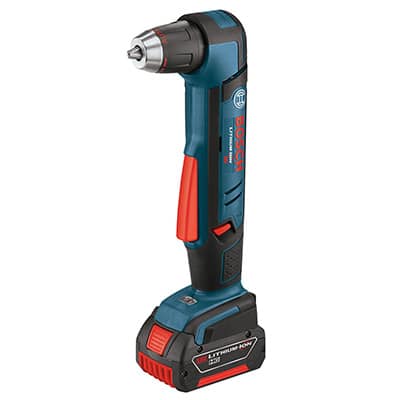
|
Best Large Chuck
|
Bosch ADS181-101
|
Features
|
Check Price at Amazon Bosch ADS181-101 Review Bosch ADS181-101 Review |
|
Best for HVAC
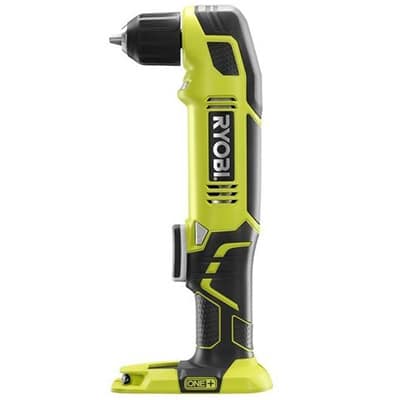
|
Best for HVAC
|
Ryobi P241
|
Features
|
Check Price at Amazon Ryobi P241 Review Ryobi P241 Review |
|
Best Trade Grade
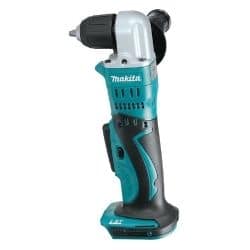
|
Best Trade Grade
|
Makita XAD02Z
|
Features
|
Check Price at Amazon Makita XAD02Z Review Makita XAD02Z Review |
|
Best for DIY
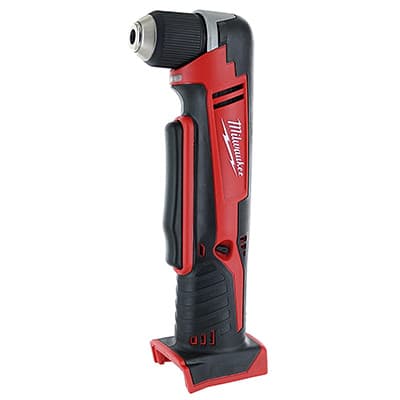
|
Best for DIY
|
Milwaukee 2615-20
|
Features
|
Check Price at Amazon Milwaukee 2615-20 Review Milwaukee 2615-20 Review |
Best Cordless Right Angle Drill Buying Guide
Lowering the risk of knocked knuckles, tool bumping, and allowing you to reach spaces inaccessible with your standard drill — these remarkably compact units are excellent for trade-pros and DIYers working inside cupboards, beneath floor joists, and between drywall slats.
Incorporating a 90-degree drilling head and permitting single-handed use, these right angle cordless drill units reduce headaches, frustrations, and operational fatigue.
Although often with slightly less brawn than the mains-driven 90-degree models — their lithium-ion power cells provide a pleasing drilling speed and allow for lengthy running times.
When choosing your 90 degree right angle drill — consider:
-
- Voltage and mAh of the power cell.
- Complete kit or bare tool.
- Rapid-replenishment charger.
- Chuck size and rotation.
- Weight of the drill — including the battery.
- Torque output.
- Speed delivery.
- Inclusion of auxiliary handle.
Do You Need a Battery Powered Right Angle Drill?
Admittedly, they lack the torque and serious crushing power of cordless hammer drills, making them unsuitable for hardcore masonry, brickwork, and concrete jobs. However, for woods, metals, plasters, and drywall applications where space is limited — only a 90-degree drill will suffice.
Running off rechargeable lithium-ion power packs, these cordless machines eliminate the need for a mains lead and extension cable — components that, at the very least, are a serious annoyance in confined areas.
If you have time-heavy projects, the limited operational times of battery-powered right angle machines could be a hindrance — in which case, I suggest checking out their corded siblings instead. That said, all manufacturers of these 90-degree drills retail additional lithium cells separately — meaning you can always have a fully-charged battery as a backup.
While not an exhaustive list, a cordless drill right angle unit is ideal for confined work such as:
-
- Working between outdoor decking joists.
- Removing/driving screws in car engines.
- Plumbing work beneath sinks and bathtubs.
- Drilling above ceiling slats.
- Creating channels for wiring or plumbing.
- Building cabinets.
- Working inside cupboards.
- Driving drywall studs.
- Operating inside lofts and attics.
- Areas where only single-handed access is viable.
- Driving/drilling between sub-floor timber joists.
How to Choose the Ultimate 90 Degree Electric Drill
Here are the key areas to consider when selecting your optimum electric angle drill:
Battery Voltage and mAh
Think of the voltage and maH rating of the battery to be akin to your between-the-sheets action — it determines your penetrating power and lasting stamina.
Typically — although not in all cases, as some machines can be geared down for torque — the higher the voltage rating, the more rapid the drill. This can be crucial if your work involves repetitive, time-intensive screwdriving.
The mAh figure indicates how long the battery continues to operate from a single charge — the higher the number, the fewer times you’ll have to recharge your power cell. At the very least, I’d consider a tool with a minimum of 3.0 mAh, such as the Bosch ADS181-101.
Bare Tool or Complete Kit
A crucial factor, and one that many novices fail to consider until it’s too late.
Many right angle 90 drill models — especially from the premium brands, such as the Ryobi P241 — arrive as a bare tool. In short, without a battery or charging unit.
So, while you may be wielding a shiny and brand-new tool in your hand, you’ll be unable to use it unless you make an additional purchase of a compatible cell and charger. Hence, it’s shrewd advice to check whether your chosen drill includes these two crucial components, as exemplified by our top pick, the DeWalt DCD740C1.
That said, many semi-pro DIYers and trade-users already have rechargeable batteries in their arsenal — making a bare-tool purchase the most cost-effective option. However, bear in mind that many lithium-cells aren’t compatible across brands — so always check the tool specs before spending your hard-earned dollars.
Fast Charging Capabilities
Where a charger is included with your machine — investigate how rapidly it can replenish a depleted power cell.
Unless you have a plethora of backup batteries, you need a fast-charger — that is, a unit that can reload a 20-volt cell in 30 minutes or less. A machine with this capability, like the DeWalt DCD740C1, reduces downtime and associated headaches and frustrations.
Chuck
The most common size for cordless 90-degree drill chucks is 0.375-inches — suitable for the majority of frequently used wood and drilling bits.
However, if your projects require beast-like borers — for example when channeling timbers for pipe and wiring access — you need a wider diameter drilling head. Some machines, like the Bosch ADS181-101, feature a 0.5-inch chuck that can handle these behemoths of bits.
Furthermore, consider whether the chuck has a pivoting head. For example, the Bosch PS11-102 boasts a chuck that can be rotated from 90 to 180 degrees — allowing you to select the consummate drilling angle to suit your material and working area demands or restrictions.
Weight
In many confined spaces, you’ll have no other option than to operate your drill with one hand. And, while the slimline and compact design of small right angle drill machines make them ideal for single-handed use — their weight may be troublesome.
Despite advancements in technology — lithium-ion power cells remain hefty, adding significant extra poundage to 90-degree machines. Although for brief drilling projects this may not be an issue, on lengthier jobs it can rapidly induce fatigue.
Therefore, always check the weight of the unit before you make a purchase — and ensure you’re looking at the weight, including the battery, not without. Alternatively, if you’re lacking in hand and arm strength, it may be advisable to opt for a corded right angle model instead.
Speed vs Torque
Freddie Mercury famously sang,
‘I want it all, I want it all, I want it all, and I want it now’
— I Want It All (1989 – Capitol Records)
Unfortunately for Freddie, he couldn’t have it all in a right-angled drill.
Buying a 90-degree machine, in fact, any drill, means a trade-off between speed and torque. The higher the rpm of the unit, the lower the grunt — and vice versa.
Hence, when selecting your new close-quarter unit — consider whether your most common projects require either rapidity or pure brawn.
Auxiliary Handle
Materials can be stubborn beasts.
Dense metals, dried hardwoods, and knotted timber can be challenging to drill. Not only do you need a machine with some serious torque — but you also may need to put in some of your own strength and sweat.
A few 90-degree machines arrive complete with a detachable auxiliary side handle. This useful accessory allows you to wield the drill two-handed — elevating your pushing power and enabling you to beat those unyielding base materials.
Conclusion
Offering freedom from mains tethering and permitting you to operate in tight spaces — a cordless 90-degree drill enables you to bore and drive in the most challenging of locations.
With an angled head, slimline design, and allowing one-handed use — these machines are ideal for home improvers and trade contractors operating inside cupboards, between joists, and under floorboards.
Agreed, their restricted running time — unless you have backup power cells — can be a downer. In which case, take a look at the corded right angle units instead. And, with limited torque, they’re underpowered for brick and concrete applications — you need a hammer drill.
However, if you demand the ultimate in portability combined with restricted-space operation — nothing less than a cordless right angle drill will suffice.
Right Angle 90 Degree Cordless Drill FAQs
Q: What Is the Purpose of a Right Angle Drill?
The compact design, snub head, and 90-degree chuck permit right-angle drills to access areas typically too small for standard-sized machines. Cordless models provide additional freedom by negating the requirement for mains access and annoying power leads.
Q: What Is the Best Right Angle Cordless Drill?
With its 0.375-inch chuck, twin speed, and arriving complete with battery pack and charger — in my opinion, the best cordless 90-degree drill is the DeWalt DCD740C1.
Q: How Do You Use an Angled Drill?
While a right angled drill isn’t challenging to operate — whether corded or cordless — it does mean having to use a somewhat alternative technique to a standard DIY drill. Take a look at the video below for top tips on effective right angle boring operation.

Q: How Long Does the Battery Last on a Right Angle Cordless Drill?
The running time of a 90-degree cordless drill depends on two factors — the mAh rating of the battery and how the unit is used.
The higher the mAh, the longer the cell will last from a single charge. Furthermore, the density of the material you’re addressing, the speed the drill is set at, and the size of the bit can all affect battery running times.
Q: Will My DeWalt 20V Max Battery Fit Ryobi Cordless Right Angle Drill?
No. The Ryobi cordless 90-degree drill requires an 18-volt power pack — not the 20 volts delivered by the DeWalt Max cell.
Q: How Long Does a 90 Degree Drill Battery Take to Charge?
If the charger has fast-charge technology, the cell can be replenished in 30 minutes or less. Standard battery chargers will take between 45 minutes to an hour to recharge a 20-volt lithium-ion cell.

